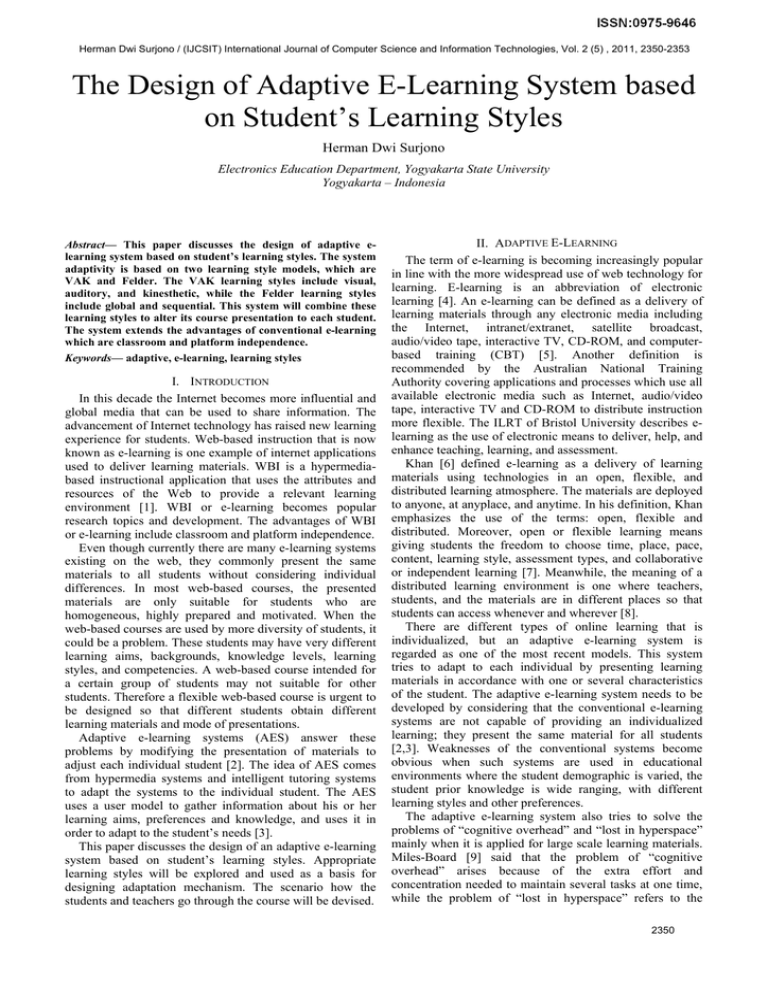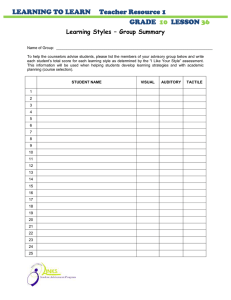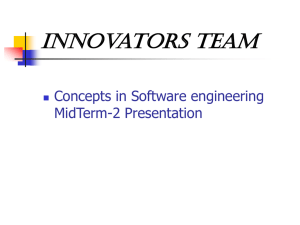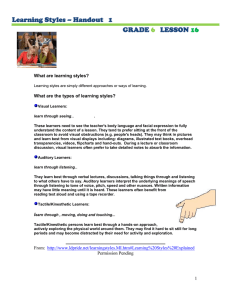The Design of Adaptive E-Learning System based on Student’s Learning Styles
advertisement

Herman Dwi Surjono / (IJCSIT) International Journal of Computer Science and Information Technologies, Vol. 2 (5) , 2011, 2350-2353 The Design of Adaptive E-Learning System based on Student’s Learning Styles Herman Dwi Surjono Electronics Education Department, Yogyakarta State University Yogyakarta – Indonesia Abstract— This paper discusses the design of adaptive elearning system based on student’s learning styles. The system adaptivity is based on two learning style models, which are VAK and Felder. The VAK learning styles include visual, auditory, and kinesthetic, while the Felder learning styles include global and sequential. This system will combine these learning styles to alter its course presentation to each student. The system extends the advantages of conventional e-learning which are classroom and platform independence. Keywords— adaptive, e-learning, learning styles I. INTRODUCTION In this decade the Internet becomes more influential and global media that can be used to share information. The advancement of Internet technology has raised new learning experience for students. Web-based instruction that is now known as e-learning is one example of internet applications used to deliver learning materials. WBI is a hypermediabased instructional application that uses the attributes and resources of the Web to provide a relevant learning environment [1]. WBI or e-learning becomes popular research topics and development. The advantages of WBI or e-learning include classroom and platform independence. Even though currently there are many e-learning systems existing on the web, they commonly present the same materials to all students without considering individual differences. In most web-based courses, the presented materials are only suitable for students who are homogeneous, highly prepared and motivated. When the web-based courses are used by more diversity of students, it could be a problem. These students may have very different learning aims, backgrounds, knowledge levels, learning styles, and competencies. A web-based course intended for a certain group of students may not suitable for other students. Therefore a flexible web-based course is urgent to be designed so that different students obtain different learning materials and mode of presentations. Adaptive e-learning systems (AES) answer these problems by modifying the presentation of materials to adjust each individual student [2]. The idea of AES comes from hypermedia systems and intelligent tutoring systems to adapt the systems to the individual student. The AES uses a user model to gather information about his or her learning aims, preferences and knowledge, and uses it in order to adapt to the student’s needs [3]. This paper discusses the design of an adaptive e-learning system based on student’s learning styles. Appropriate learning styles will be explored and used as a basis for designing adaptation mechanism. The scenario how the students and teachers go through the course will be devised. II. ADAPTIVE E-LEARNING The term of e-learning is becoming increasingly popular in line with the more widespread use of web technology for learning. E-learning is an abbreviation of electronic learning [4]. An e-learning can be defined as a delivery of learning materials through any electronic media including the Internet, intranet/extranet, satellite broadcast, audio/video tape, interactive TV, CD-ROM, and computerbased training (CBT) [5]. Another definition is recommended by the Australian National Training Authority covering applications and processes which use all available electronic media such as Internet, audio/video tape, interactive TV and CD-ROM to distribute instruction more flexible. The ILRT of Bristol University describes elearning as the use of electronic means to deliver, help, and enhance teaching, learning, and assessment. Khan [6] defined e-learning as a delivery of learning materials using technologies in an open, flexible, and distributed learning atmosphere. The materials are deployed to anyone, at anyplace, and anytime. In his definition, Khan emphasizes the use of the terms: open, flexible and distributed. Moreover, open or flexible learning means giving students the freedom to choose time, place, pace, content, learning style, assessment types, and collaborative or independent learning [7]. Meanwhile, the meaning of a distributed learning environment is one where teachers, students, and the materials are in different places so that students can access whenever and wherever [8]. There are different types of online learning that is individualized, but an adaptive e-learning system is regarded as one of the most recent models. This system tries to adapt to each individual by presenting learning materials in accordance with one or several characteristics of the student. The adaptive e-learning system needs to be developed by considering that the conventional e-learning systems are not capable of providing an individualized learning; they present the same material for all students [2,3]. Weaknesses of the conventional systems become obvious when such systems are used in educational environments where the student demographic is varied, the student prior knowledge is wide ranging, with different learning styles and other preferences. The adaptive e-learning system also tries to solve the problems of “cognitive overhead” and “lost in hyperspace” mainly when it is applied for large scale learning materials. Miles-Board [9] said that the problem of “cognitive overhead” arises because of the extra effort and concentration needed to maintain several tasks at one time, while the problem of “lost in hyperspace” refers to the 2350 Herman Dwi Surjono / (IJCSIT) International Journal of Computer Science and Information Technologies, Vol. 2 (5) , 2011, 2350-2353 tendency to lose one’s sense of location and orientation in a hypermedia system. According to Kay [10], there are two types of adaptation in the adaptive e-learning system depending on who takes the initiatives: the system or the student. When the system which initiates, it is called adaptivity and when the student who initiates, it is called adaptability. Adaptivity refers to the capability of a system to alter its presentation according to the student characteristics automatically, while adaptability refers to the capability of the system to support user modification. The term of adaptive and adaptable is often confusing. Systems that can adapt automatically to the users based on the system’s assumptions about user characteristics are called adaptive. Systems that allow the user to make changes certain parameters and adapt their behaviour accordingly are called adaptable [11]. In designing the adaptive e-learning system, it is important to balance between these two levels of adaptation [12]. III. LEARNINGS STYLES There are several definitions of learning styles. According to Bennet [13], learning style is the way a student prefers to learn. James and Blank [14] defined learning style as the complex method in which learners most efficiently and most effectively perceive process, store and recall what they are trying to learn. McLoughlin [15] summarizes the term of learning style as adopting a typical and distinct mode of learning. In addition, Honey and Mumford [16] defined the learning style as the attitudes and behaviours that determine student’s preferred ways of learning. Learning style influences the effectiveness of training, whether that training is provided on-line or in more traditional ways [17]. According to Riding and Cheema [18], learning style constructs can be classified as wholist-analytical and verbaliser-imager. The wholist-analytical describes how individuals process information. Wholists prefer to learn material globally, while analysts are likely to process information in details. The verbaliser-imager describes how individuals express information. Verbalisers prefer to present information in words, while imagers tend to present information in pictorial form [15]. Pask [19] mentioned wholist-analytical as holist-serialist. According to Pask, holists prefer to begin with an overview of material and then proceed to details, while serialists tend to follow step-by-step instruction. According to Felder et al. [20], wholist and serialist are known as global and sequential; while verbalise and imager are known as verbal and visual. Sequential Learners: These learners tend to learn in linear steps following logical step-by-step paths. Global Learners: These learners prefer to learn in large jumps. According to Sarasin [21], most learners can be categorized as Visual, Auditory or Kinesthetic learners depending on how they prefer to receive and process information. Visual learners can learn effectively when they see the materials, Auditory learners like to hear the material, while Kinesthetic learners are those who learn best by doing. These three categorises are known as VAK learning styles. The VAK learning styles refer to human observation channels: vision, hearing and feeling. It suggests that learners can be divided into one of three preferred learning styles, i.e. Visual, Auditory or Kinesthetic. Auditory Learners: These learners prefer to absorb information by listening. They learn best from listening to lectures, participating in discussions and talking things out. When they recall information, they will remember the way they heard it. Visual Learners: These learners learn best when information is presented in pictures, tables, charts, maps or diagrams. Seeing and reading are important activities for visual learners. Kinesthetic Learners: These learners learn best through feeling and doing. They prefer lab activities or field trips over classroom lectures. They like to be involved with physical experiences; touching, feeling, holding, doing, and practical hands-on experiences. Each learning style model has its own instrument for measuring the learners that is usually in the form of questionnaires. The questionnaire comprises several questions about learner personality, attitude, and behaviour. In this paper, the VAK learning styles will be combined with Felder learning styles of global and sequential. The questionnaire includes indicators to measure the learner preferred learning styles of Visual, Auditory or Kinesthetic and Global or Sequential. Based on the scores the learners obtain, they can be classified into one of these categories (known as learning modes): • Global-Visual • Global-Auditory • Global-Kinesthetic • Sequential-Visual • Sequential-Auditory • Sequential-Kinesthetic IV. SYSTEM DESIGN The term of learning mode used in this system refers to a combination of presentation mode Global-Sequential with variations of VAK. Because there are six types of learning modes that must be accommodated, then the system must provide six kinds of presentations. Learning mode of "Global-Visual" means the material is presented globally by focusing on the visual aspect. Learning mode of "GlobalAuditory" means the material is presented globally with major elements of the audio aspect. Learning mode of "Global-Kinesthetic" means the material is presented globally with emphasis on the kinesthetic aspect. For the other three learning modes that are "Sequential-Visual", "Auditory-Sequential," "Sequential-Kinesthetic", the learning materials are the same as the three previous modes, but they are presented sequentially. Teachers are responsible for devising and editing all the learning materials. In addition, teachers are allowed to edit the questionnaires. A flowchart for teachers is illustrated at figure 1. 2351 Herman Dwi Surjono / (IJCSIT) International Journal of Computer Science and Information Technologies, Vol. 2 (5) , 2011, 2350-2353 Fig 1 : Teacher’s Flow chart On the other hand, students have to fill out the questionnaires when the first time accessing the adaptive course. After learning the adaptive materials and taking the quiz, if the score is lower than the passing grade, students have an option to refill the questionnaires. If the score is the same to or greater than the passing grade meaning that their learning style is matched with the mode of presentation, students cannot access the questionnaires. They can continue to learn the materials. A flowchart for students is illustrated at figure 2. Fig 2 : Students’s Flow chart 2352 Herman Dwi Surjono / (IJCSIT) International Journal of Computer Science and Information Technologies, Vol. 2 (5) , 2011, 2350-2353 A mechanism used to decide whether a student will get a certain mode of learning is very simple. The questionnaire contains questions that ask the propensity of learning styles in which the answers are grouped into two, the first group: visual, auditory, kinesthetic and second group: global, sequential. For example if a student obtains the highest score on the visual aspect of the first group and highest score on the global aspect of the second group, then students will proceed to the learning mode of "GlobalVisual". Another example, a student will learn with a learning mode of “Sequential-Auditory”, when she or he gets the highest score on the auditory aspect of the first group and highest score on the sequential aspect of the second group. The number of questions in the questionnaires must be odd or cannot be divided by 3 for the first group and cannot be divided by 2 for the second group. The disadvantage of this mechanism, among others, although the number of questions is not divisible by 3, but there is still a possibility that the two aspects got the same score. If this happens, then the system will choose the one that may not match the student’s learning styles. In addition, when filling out the questionnaire for the second chance, students may still remember some of the questions, if this happens then the score may not reflect their actual learning styles. The next step after the design is the implementation. The adaptive e-learning system can be implemented using a Learning Management System such as Moodle. The LMS Moodle offers a variety of features to support teachers in creating, administering, and managing online courses. However, as a standard Moodle does not consider individual differences of learners and treat all learners equally, in order to accommodate the learners’ learning styles of Visual, Auditory or Kinesthetic and of Global or Sequential; it needs to be customized. Customizing Moodle to implement the design diagrams as shown at figures 1 and 2 needs further work. V. CONCLUSIONS The adaptive e-learning system that is designed in this paper is expected to present learning materials that match students' learning styles i.e. visual, auditory and kinesthetic either globally or sequentially. There are six learning modes that are accommodated in the system, i.e. Global-Visual, Global-Auditory, GlobalKinesthetic, Sequential-Visual, Sequential-Auditory and Sequential-Kinesthetic. The learning mode refers to a combination of presentation mode Global-Sequential with variations of VAK. A basis used in deciding to follow a particular learning mode is the highest score obtained in each group of learning styles. REFERENCES [1] [2] [3] [4] [5] [6] [7] [8] [9] [10] [11] [12] [13] [14] [15] [16] [17] [18] [19] [20] [21] Khan, B. H. (1997). Web-based instruction (WBI): What is it and why is it? In B. H. Khan (Ed.), Web-based instruction (pp. 5-18). Englewood Cliffs, NJ: Educational Technology Publications. Brusilovsky, P. (1996). Methods and techniques of adaptive hypermedia. User Modeling and User Adapted Interaction, 6(2-3), 87-129. Brusilovsky, P. (2001). Adaptive hypermedia. User Modeling and User Adapted Interaction, 11, 87-110. Sohn, B. (2005). E-learning and primary and secondary education in Korea. KERIS Korea Education & Research Information Service, 2(3), 6-9. Gilbert, & Jones, M. G. (2001). E-learning is e-normous. Electric Perspectives, 26(3), 66-82. Khan, B. H. (2005). Managing e-learning: Design, delivery, implementation and evaluation. Hershey, PA: Information Science Publishing. Lai, K., Pratt, K., & Grant, A. (2003). State of the art and trends in distance, flexible, and open learning: A review of the literature. Dunedin, New Zealand: School of Education, University of Otago. Saltzbert, S., & Polyson, S. (1995). Distributed learning on the World Wide Web. Syllabus, 9(1), 10-12. Miles-Board, T. J. (2004). Everything integrated: A framework for associative writing in the web. Unpublished doctoral dissertation, University of Southampton, Southampton. Kay, J. (2001). Learner control. User Modeling and User Adapted Interaction, 11(1-2), 111-127. Oppermann, R., Rashev, R., & Kinshuk. (1997, July 14-16). Adaptability and adaptivity in learning system. Paper presented at the Knowledge Transfer, London, UK. Papanikolaou, Grigoriadou, M., Kornilakis, H., & Magoulas, G. D. (2003). Personalizing the interaction in a web-based educational hypermedia system: The case of INSPIRE. User Modeling and User Adapted Interaction, 13(3), 213-267. Bennett, C. (1979). Individual differences and how teachers perceive them. The Social Studies, 70(2), 56-61. James, W. B., & Blank, W. E. (1993). Review and critique of available learning-style instruments for adults. In D. Flannery (Ed.), Applying cognitive learning styles (pp. 47-58). San Francisco: Jossey-Bass. McLoughlin, C. (1999). The implications of research literature on learning styles for the design of instructional material. Australian Journal of Educational Technology, 15(3), 222-241. Honey, P., & Mumford, A. (1992). The Manual of Learning Styles (3rd ed.). Maidenhead, UK: Peters Honey. Benham, H. C. (2002). Training effectiveness, online delivery and the influence of learning style. Paper presented at the 2002 ACM SIGCPR Conference on Computing Personal Research, Kristiansand, Norway. Riding, R., & Cheema, I. (1991). Cognitive styles: An overview and integration. Educational Psychology: An International Journal of Experimental Educational Psychology, 11(3-4), 193-215. Pask, G. (1988). Learning strategies, teaching strategies, and conceptual or learning styles. In R. Schmeck (Ed.), Learning strategies and learning styles. New York: Plenum Press. Felder, R. M., & Silverman, L. K. (1988). Learning and teaching styles in engineering education. Engineering Education, 78(7), 674681. Sarasin, Lynne Celli. (1999) Learning Style Perspectives, Impact in the Classroom. Madison, WI: Atwood Publishing. 2353




